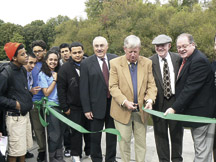An academy opened this September to help guide students who were becoming too old for their North Hudson grammar schools, but are not yet ready to transition to high school – and it’s being taught without the use of text books.
Students in seventh and eighth grade were recommended by their respective guidance counselors last spring for the Hudson County Schools of Technology’s new North Hudson Park Environmental Academy.
The inaugural class for the one-year program, which is meant to transition students from grammar school to high school, is comprised of eight girls and 16 boys from North Bergen, Guttenberg, West New York, and Weehawken.
“Everything comes to life.” – JC Melendez
________
The academy opened on Sept. 2. On Oct. 14, officials celebrated, including HCST Superintendent Frank Gargiulo, Hudson County Executive Thomas DeGise, various Hudson County freeholders, Hudson County Sheriff Juan Perez, Hudson County Director of Parks Thomas McCann, and other local superintendents, administrators, teachers, and guidance counselors.
Gargiulo said that talks began five years ago about opening another school in the building. He thought that the park would be a perfect for students to study the environment.
“The school has been in existence for six weeks, so I can’t say how great the school is [yet],” said Gargiulo. “I can only say that the vision is to make every young man and woman sitting next to us as best as they can and transition them into our high schools.”
Students who had difficult functioning with traditional curricula now begin many of the lessons as field experiences in the park and on trips, like the Hudson River, Sandy Hook and a future excursion to a wolf preserve. Scientific, language arts, mathematic and social studies project-based lessons follow.
The building has two floors, with the first housing two labs, while the second has personal work stations for each student. They will also receive laptops to complete research. The second floor deck has exercise equipment.
Outfitting the building with new technology cost the HCST around $100,000, said Gargiulo.
Gargiulo said that students who rarely attended school now have perfect attendance and want to be there. He admitted that he had trouble learning in a traditional environment and wishes he could have had been a student here.
A sense of belonging
During the opening ceremony, Supervisor of Instruction Amy Lin-Rodriguez, who had worked on other alternative academies, said that the school was a miracle for the 24 students.
The school has worked with Ramapo College’s Meadowlands Environment Center and Rutgers Universities’ Department of Environmental Sciences. Other local environmental groups, including the Hackensack Riverkeeper and the Hudson River Fisherman Association, have trips planned for students.
Melissa Perez, who had previously attended Franklin Elementary School in North Bergen, broke down while reading her speech during ceremony, and Rodriguez finished reading her work. A teary-eyed Perez stood by her side. The speech thanked Gargiulo for turning the building into a home for her fellow classmates.
Student presentations
Students made presentations demonstrating their environmental inquires.
JC Melendez of Weehawken had set up posterboard explaining what species of fish they had caught so far on their excursions, while a nearby table displayed microscopes with phytoplankton the students had collected from the lake. In the same room was a boat that they were currently preparing for the spring, which they will use to explore the lake.
“It’s a great learning experience,” said Melendez. “Everything comes to life. [We are] students that like to learn and are happy to come to school every day, sit down, and focus.”
Teaching students, not subjects
Environmental Facilitator John Ponticorvo said that there was already clear growth in the students. He said these students could have otherwise fallen “through the cracks.”
Rodriguez said that one of the truly remarkable occurrences of the day were the reactions for the students’ previous guidance counselors. She said most could not believe the transformations. For instance, one student had trouble speaking to adults in the past, but was now making a presentation in front of everyone.
“I think you have to make learning real for these kids, and what is written in a textbook is only one person’s point of view,” said Rodriguez.
Lory Mercer, the administrator for the HCST alternative high school Hudson Academy, thought that the program proved how project-based learning could reach students.
“We need more schools like this because we’re just so used to teaching subjects and not children,” said Mercer.
North Bergen Mayor Nicholas Sacco, who is also his district’s assistant superintendent, thought the program utilized an underused building while providing an alternate teaching style that reached all students.
Tricia Tirella may be reached at TriciaT@hudsonreporter.com.
